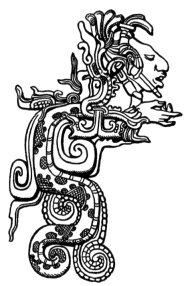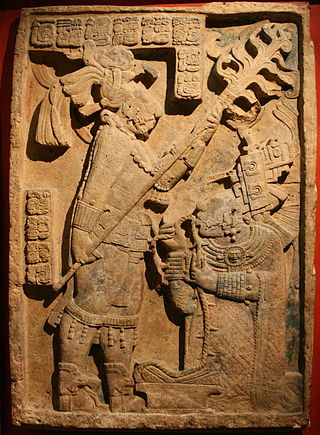
Year 752 (DCCLII) was a leap year starting on Saturday of the Julian calendar, the 752nd year of Common Era (CE) and Anno Domini (AD) designations, the 752nd year of the 1st millennium, the 52nd year of 8th century, and the 3rd year of the 750s decade. The denomination 752 for this year has been used since the early medieval period, when the Anno Domini calendar era became the prevalent method in Europe for naming years.

Palenque, also anciently known in the Itza Language as Lakamhaʼ, was a Maya city state in southern Mexico that perished in the 8th century. The Palenque ruins date from ca. 226 BC to ca. 799 AD. After its decline, it was overgrown by the jungle of cedar, mahogany, and sapodilla trees, but has since been excavated and restored. It is located near the Usumacinta River in the Mexican state of Chiapas, about 130 km (81 mi) south of Ciudad del Carmen, 150 meters (490 ft) above sea level. It is adjacent to the modern town of Palenque, Chiapas. It averages a humid 26 °C (79 °F) with roughly 2,160 millimeters (85 in) of rain a year.

Yaxchilan is an ancient Maya city located on the bank of the Usumacinta River in the state of Chiapas, Mexico. In the Late Classic Period Yaxchilan was one of the most powerful Maya states along the course of the Usumacinta River, with Piedras Negras as its major rival. Architectural styles in subordinate sites in the Usumacinta region demonstrate clear differences that mark a clear boundary between the two kingdoms.

Kʼinich Janaab Pakal I, also known as Pacal or Pacal the Great, was ajaw of the Maya city-state of Palenque in the Late Classic period of pre-Columbian Mesoamerican chronology. He acceded to the throne in July 615 and ruled until his death. Pakal reigned 68 years—the fifth-longest verified regnal period of any sovereign monarch in history, the longest in world history for more than a millennium, and still the longest of reign of any monarch in the history of the Americas. During his reign, Pakal was responsible for the construction or extension of some of Palenque's most notable surviving inscriptions and monumental architecture. Pakal is perhaps best known in popular culture for his depiction on the carved lid of his sarcophagus, which has become the subject of pseudoarchaeological speculations.

The Vision Serpent is an important creature in Pre-Columbian Maya mythology, although the term itself is now slowly becoming outdated.
Janahb Pakal also known as Janaab Pakal, Pakal I or Pakal the Elder,, was a nobleman and possible ajaw of the Maya city-state of Palenque.

Sak Kʼukʼ also known as Muwaan Mat, Lady Sak Kʼukʼ and Lady Beastie, was queen of the Maya city-state of Palenque. She acceded to the throne in October, 612 and ruled until 615.
Kʼinich Janaabʼ Pakal (603–683) was ajaw of the Maya city-state of Palenque in the Late Classic period of pre-Columbian Mesoamerican chronology.
Yohl Ikʼnal, also known as Lady Kan Ik and Lady Kʼanal Ikʼnal, was queen regnant of the Maya city-state of Palenque. She acceded to the throne on 23 December 583, and ruled until her death.

Lintel 24 is the designation given by modern archaeologists to an ancient Maya limestone sculpture from Yaxchilan, in modern Chiapas, Mexico. The lintel dates to about 723–726 AD, placing it within the Maya Late Classic period. Its mid-relief carving depicts the ruler of Yaxchilan, Itzamnaaj Bahlam III, and his consort Lady K’abal Xoc, performing a ceremony of bloodletting; the imagery is also accompanied by descriptive captions, and a signature by the sculptor, Mo’ Chaak.

Lady Kʼabʼal Xook or Lady Xoc, was a Maya Queen consort of Yaxchilan. She was the principal wife and aunt of King Itzamnaaj Bahlam III, who ruled the prominent kingdom of Yaxchilan from 681 to 742. She is believed by many to have been the sister of Lady Pacal.
B'alam, Balam, Balaam, B'ahlam, Bahlam, Bahlum or Bolom may refer to:
Maya monarchs, also known as Maya kings and queens, were the centers of power for the Maya civilization. Each Maya city-state was controlled by a dynasty of kings. The position of king was usually inherited by the oldest son.

Yaxun Bʼalam III (also known as 6-Tun-Bird-Jaguar) was a high king of the Mayan city Yaxchilan from 631 until 681.

Lady Eveningstar or Lady Ikʼ Skull (704-751), was a Maya queen and possible regent, wife of Itzamnaaj Bʼalam III, a Maya king of Yaxchilan. Their son, Yaxun Bʼalam IV - "Bird Jaguar", succeeded his father as king. She was possibly a regent between 742 and 751.
During the 6th and 7th centuries in Mesoamerica, there was an evident shift in the roles women played in ancient Maya society as compared with the previous two centuries. It was during this time that there was a great deal of political complexity seen both in Maya royal houses as well as in the Maya area. Warfare was a significant factor in political competition and marriage was one of the ways that alliances were made between the different polities. This was accompanied by a shift in women's roles from wife and mother to playing integral parts in courtly life, such as participating in rituals involving the supernatural world and at times ruling individual polities.
Yoʼnal Ahk III, also known as Ruler 5, was an ajaw of Piedras Negras, an ancient Maya settlement in Guatemala. He ruled during the Late Classic Period, from 758 to 767 AD. Yoʼnal Ahk III ascended to the throne upon the death of Itzam Kʼan Ahk II, who may have been Yoʼnal Ahk's father. He was succeeded by his probable brother, Haʼ Kʼin Xook in around 767 AD. Yoʼnal Ahk III left behind two surviving stelae at Piedras Negras, namely Stelae 14 and 16, the former of which has been called one of the finest niche stelae, according to Simon Martin and Nikolai Grube.

Itzamnaaj Bahlam III was a Mayan king of the city of Yaxchilan which is now located in Chiapas, Mexico. He rose to power in October 681 and continued to rule until his death in June 742. Itzamnaaj Bahlam III is best known for the many buildings and stelae he commissioned during his rule, many of which are still found at Yaxchilan today. He was spouse to Lady Ik' Skull who herself ruled for a time.
Itzamnaaj Bʼalam II was a Mayan king who ruled in Yaxchilan. Experts usually date his reign between the end of the 6th century and the beginning of the 7th century, around 599 or even until around 610. Very little is known of him. He is also called Shield Jaguar by modern writers, based on the name glyph before the phonetic name was deciphered.











